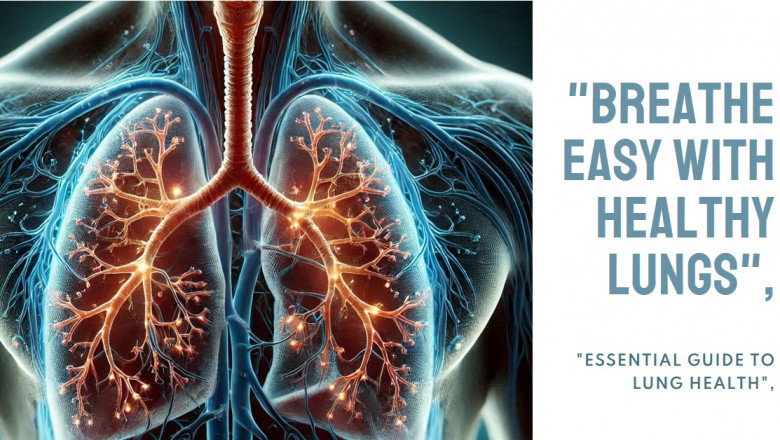views
Introduction
Pulmonary Function Testing (PFT) is an essential diagnostic tool used to evaluate the respiratory system’s functionality. Whether you’re experiencing chronic respiratory issues, preparing for surgery, or managing a condition like asthma, understanding PFT can empower you to take charge of your lung health. This article dives deep into what pulmonary function tests are, their types, and why they matter for maintaining respiratory well-being.
What Is Pulmonary Function Testing?
These Function Testing comprises a group of non-invasive tests that measure how well your lungs work. The primary goals of PFT are to:
-
Assess lung volume, capacity, rates of flow, and gas exchange.
-
Diagnose respiratory disorders such as asthma, chronic obstructive pulmonary disease (COPD), and pulmonary fibrosis.
-
Monitor disease progression or response to treatment.
-
Evaluate the effect of exposure to harmful substances like industrial fumes.
Importance
Lung diseases account for 10% of all deaths worldwide, according to the World Health Organization (WHO). Early diagnosis through tools like PFT can prevent complications, improve quality of life, and reduce mortality.
Pulmonary Function Testing is particularly crucial for:
-
Smokers: Detecting early signs of lung damage.
-
Individuals with Chronic Conditions: Monitoring asthma, COPD, or interstitial lung diseases.
-
Pre-surgical Assessments: Evaluating lung function before major surgeries.
-
Occupational Health: Screening workers exposed to lung irritants.
Types of Pulmonary Function Tests
1. Spirometry
The most common PFT, spirometry measures the amount and speed of air you can inhale and exhale. It’s particularly useful for diagnosing asthma and COPD.
-
Key Metrics:
-
Forced Vital Capacity (FVC): Maximum air exhaled after deep inhalation.
-
Forced Expiratory Volume in 1 Second (FEV1): Air exhaled in the first second.
-
-
Typical Procedure: You breathe into a mouthpiece connected to a spirometer.
2. Lung Volume Tests
These tests measure the total lung capacity (TLC) and residual volume (RV) using methods like plethysmography or helium dilution.
-
Importance: Helps diagnose restrictive lung diseases where lung expansion is limited.
3. Diffusion Capacity Test (DLCO)
DLCO measures how efficiently oxygen moves from your lungs to your bloodstream.
-
Relevance: Used to evaluate diseases like pulmonary fibrosis and emphysema.
4. Peak Flow Measurement
A portable test that measures how quickly you can exhale. It’s often used for daily monitoring in asthma management.
5. Exercise Stress Tests
These tests assess how well your lungs perform under physical stress, providing insights into exercise-induced asthma or unexplained shortness of breath.
How to Prepare for Pulmonary Function Testing
-
Medication Guidelines: Avoid bronchodilators or other medications as instructed.
-
Diet: Refrain from heavy meals before the test.
-
Clothing: Wear loose, comfortable attire.
-
Smoking and Caffeine: Avoid these for at least four hours before testing.
What to Expect During Pulmonary Function Testing
-
Duration: Tests typically last between 30 to 90 minutes.
-
Procedure: You’ll sit in a sealed chamber or use a mouthpiece, following the technician’s instructions.
-
Safety: PFT is non-invasive and generally safe, though you might feel slight discomfort during forced breathing.
Interpreting Pulmonary Function Test Results
PFT results are compared to average values based on your age, gender, height, and ethnicity.
-
Normal Results: Indicate healthy lung function.
-
Abnormal Results: May point to obstructive or restrictive lung diseases, warranting further investigation.
Common patterns include:
-
Obstructive: Reduced airflow (e.g., asthma, COPD).
-
Restrictive: Reduced lung volume (e.g., pulmonary fibrosis).
Advancements
With technological innovations, modern PFT devices now offer more accurate and comprehensive assessments. Some advancements include:
-
Portable Spirometers: Enabling home-based monitoring.
-
AI Integration: Enhancing diagnostic accuracy.
-
Telemedicine Compatibility: Facilitating remote consultations.
FAQs
1. Who should undergo these Function Testing? Anyone experiencing persistent respiratory symptoms like shortness of breath, chronic cough, or wheezing should consider PFT. It’s also recommended for individuals with a family history of lung diseases or those exposed to occupational hazards.
2. Is these Function Testing painful? No, PFT is non-invasive and painless. Some tests might cause mild discomfort due to forced breathing.
3. How often should PFT be done? Frequency depends on your condition. For chronic diseases like COPD, annual testing is common.
4. Can children undergo these Function Testing? Yes, spirometry can be performed on children aged five and above with proper guidance.
5. Are there any risks involved? PFT is safe for most individuals. However, people with severe respiratory conditions or recent heart surgery should consult their doctor beforehand.
Conclusion
These Function Testing is a cornerstone in respiratory healthcare, aiding in early detection, effective treatment, and better management of lung diseases. If you’re concerned about your respiratory health or managing a chronic condition, consult a specialist to determine if PFT is right for you. Are you ready to prioritize your lung health and take the next step?Also know The Best Nearest X-Ray Lab: How to Choose the Right Facility for Your Needs






















Comments
0 comment